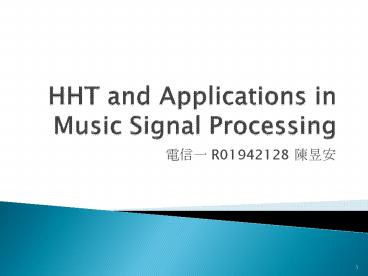HHT and Applications in Music Signal Processing - PowerPoint PPT Presentation
1 / 87
Title: HHT and Applications in Music Signal Processing
1
HHT and Applications in Music Signal Processing
- ??? R01942128 ???
2
About the Presenter
- Research area MER
- ?Not quite good at difficult math
3
About the Topic
- HHT abbreviation ofHilbert-Huang Transform
- Decided after the talk given byDr. Norden E.
Huang
4
Why HHT?
- Fourier is nice, but not good enough
- Clarity
- Non-linear and non-stationary signals
5
Hilbert-Huang Transform
Hilbert Transform
Empirical Mode Decomposition
6
Hilbert Transform
- Not integrable at tt
- Defined using Cauchy principle value
7
Dealing with 1/(t-t)
0
-8
8
tt
8
Quick Table
Input u(t) Output Hu
sin(t) -cos(t)
cos(t) sin(t)
exp(jt) -jexp(jt)
exp(-jt) jexp(-jt)
9
I know how to compute Hilbert Transform
10
Thats cool
SO WHAT?
11
- exp(jz) cos(z) jsin(z)
- exp(j?t) cos(?t) jsin(?t)
- ?(t) arctan(sin(?t)/cos(?t))
- Freq.d?/dt
12
- S(t) u(t) jHu(t)
- ?(t) arctan(Im/Re)
- Freq.d?/dt
- What happen if u(t) cos(?t) ?
Hint Hcos(t) sin(t)
13
Frequency Analysis with HT
- Input u(t)
- Calculate v(t) Hu(t)
- Set s(t) u(t) jv(t)
- ?(t) arctan(v(t)/u(t))
- fu(t) d ?(t) /dt
14
Congrats!!!
Forgot something?
15
Hilbert-Huang Transform
Hilbert Transform
Empirical Mode Decomposition
16
0
8
F 1Hz
17
0
8
F 1Hz
18
0
8
F 1Hz
19
0
8
1Hz
F
1/8Hz
20
21
To make instantaneous frequency MEANINGFUL
22
Need to decompose signals into BASIC components
23
Empirical Mode Decomposition
- Decompose the input signal
- Goal find basic components
- Also know as IMF
- Intrinsic Mode Functions
- BASIC means what?
24
Criteria of IMF
- num of extrema - num of zero-crossings 1
- At any point, the mean value of the envelope
defined by the local maxima and the envelope
defined by the local minima is zero.
25
TO BE SHORT
26
IMFs
are signals
27
Oscillate
28
Around 0
0
29
Review EMD
- Empirical Mode Decomposition
- Used to generate IMFs
EMD
30
Review EMD
- Empirical Mode Decomposition
- Used to generate IMFs
Hint Empirical means NO PRIOR KNOWLEDGES NEEDED
EMD
31
Application ISource Separation
32
Problem
33
Problem
Source Separation
34
What if We apply STFT, then extract different
components from different freq. bands?
35
Problem Solved? No!
36
Gabor Transform of piano
37
Gabor Transform of organ
38
Gabor Transform of piano organ
39
I see So how to make sure we do it right?
40
(No Transcript)
41
How to win Doraemon in paper-scissor-stone?
Easy. Paper always win.
42
The tip is to know the answer first!
43
Single-MixtureAudio Source Separationby
Subspace Decompositionof Hilbert
Spectrum Khademul Islam Molla, and Keikichi
Hirose
44
Approximation of sources
Desired result
45
PHASE I Construction of possible source model
46
IMFs
EMD
HilbertTransform
HilbertSpectra
Original Signal IMF 1 IMF 2 IMF 3
Spectrum of
47
...
frequency
48
Original Signal
Projection 2
IMF1
Projection 1
IMF2
49
AFTER SOME PROCESSING
50
RESULTS IN
51
INDEPENDENT BASIS
52
Frequency Band II
Frequency Band I
53
Hint Data points are different observations
Frequency Band II
Frequency Band I
54
SoWhat does this basis mean?
Frequency Band II
Frequency Band I
55
3F1 4F2
Frequency Band II
7F1 2F2
Frequency Band I
56
Gabor Transform of piano
F(piano) 10F1 9F2 F3
3F1 4F2
7F1 2F2
3F2 F3
57
Find Source Models
58
Cluster Basis Vectors
59
Cluster
60
Raw data
61
Clustered
62
Approximated Sources In hand!
63
Finally
- The figure of sources obtained
- We have been through
- EMD Obtain IMFs
- Hilbert Transform Construct spectra
- Projection Decompose signal in frequency space
- PCA and ICA Independent vector basis
- Clustering Combine correlated vectors together
- Voila!
64
PHASE II Reconstruction of separated source
signals
65
Reconstruction
- Spectrum of each source is a linear combination
of the vector basis generated
Signal Spectrum
Combination of sources spectra
66
Reconstruction
- Let the clustered vector basis to be Yj
- Then the weighting of this subspace is
67
(No Transcript)
68
Conclusions
- Why HHT?
- EMD needs NO PRIOR KNOWLEDGE
- Hilbert transform suits for non-linear and
non-stationary condition - However, clustering
69
Application IIFundamental Frequency Analysis
70
Problem
STFT of C4(262Hz)
Music Instrument Samples of U. Iowa
71
FUNDAMENTAL FREQUENCY ESTIMATION FOR MUSIC
SIGNALS WITH MODIFIED HILBERT-HUANG
TRANSFORM EnShuo Tsau, Namgook Cho and C.-C. Jay
Kuo
72
Basic Idea
EMD
73
Problems of EMD
- Mode mixing
- Extrema finding
- Boundary effect
- Signal perturbation
74
References
- Kizhner, S. Flatley, T.P. Huang, N.E. Blank,
K. Conwell, E. , "On the Hilbert-Huang
transform data processing system development,"
Aerospace Conference, 2004. Proceedings. 2004
IEEE , vol.3, no., pp. 6 vol. (xvi4192), 6-13
March 2004 - Md. Khademul Islam Molla Keikichi Hirose ,
"Single-Mixture Audio Source Separation by
Subspace Decomposition of Hilbert Spectrum,"
Audio, Speech, and Language Processing, IEEE
Transactions on , vol.15, no.3, pp.893-900, March
2007 - EnShuo Tsau Namgook Cho Kuo, C.-C.J. ,
"Fundamental frequency estimation for music
signals with modified Hilbert-Huang transform
(HHT)," Multimedia and Expo, 2009. ICME 2009.
IEEE International Conference on , vol., no.,
pp.338-341, June 28 2009-July 3 2009 - Te-Won Lee Lewicki, M.S. Girolami, M.
Sejnowski, T.J. , "Blind source separation of
more sources than mixtures using overcomplete
representations," Signal Processing Letters, IEEE
, vol.6, no.4, pp.87-90, April 1999
75
QA
- ????????
76
Thank you for your attention!
- THE END
77
Recycle bin
78
Quick Table
Input u(t) Output Hu
sin(t) -cos(t)
cos(t) sin(t)
exp(jt) -jexp(jt)
exp(-jt) jexp(-jt)
Insight Hilbert transform rotate input by p/2on
complex plane
79
EMD
80
81
Original Signal
Projection 2
IMF1
Projection 1
IMF2
82
Data Spread on Vector Space
83
PCA
ICA
84
PCA
ICA
85
PCA
Fact PCA ICA are linear transforms
ICA
86
FAQ
87
Q Why Hilbert Transform?































